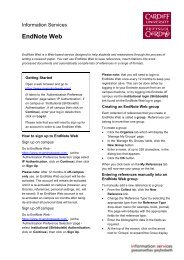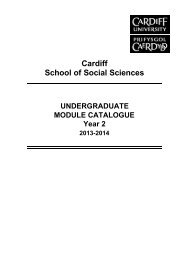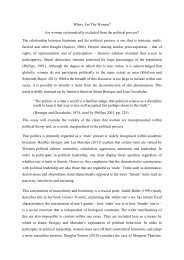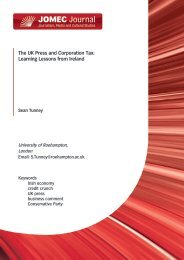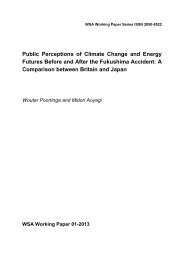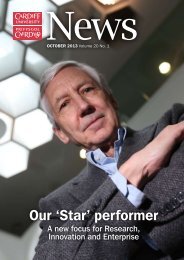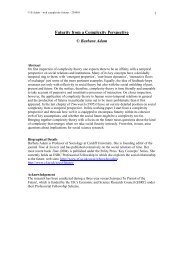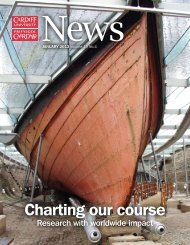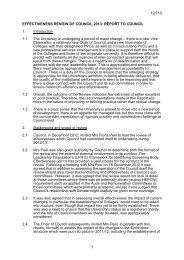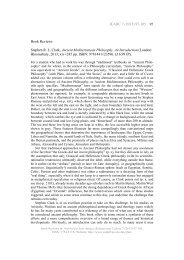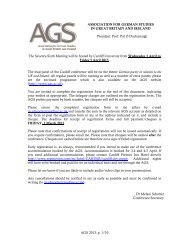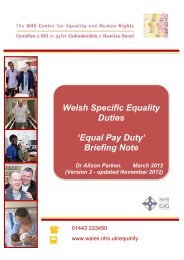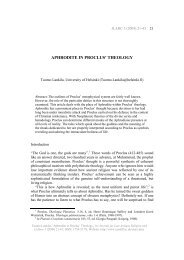Tina Askanius - Cardiff University
Tina Askanius - Cardiff University
Tina Askanius - Cardiff University
Create successful ePaper yourself
Turn your PDF publications into a flip-book with our unique Google optimized e-Paper software.
Introduction<br />
Convergence, hybridity, and found<br />
footage re-appropriation are defining<br />
features of contemporary online video<br />
activism and political discourse in a<br />
digital age more generally. The practices<br />
of remixing and re-framing moving<br />
images for political purposes have<br />
however been around since the<br />
invention of film. Over time such media<br />
practices have been given many names:<br />
media jamming, détournement, found<br />
footage filmmaking, avant garde film,<br />
television hacking, guerrilla television,<br />
telejusting, political remix, subversive<br />
remix, scratch video and fan vidding,<br />
along with more stagy designations such<br />
as cultural terrorism or cybernetic<br />
guerrilla warfare (McIntosh 2012). The<br />
political use and critical potency of such<br />
remixes is thus not fundamentally new in<br />
itself or confined to the qualities of what<br />
we today understand as new media. The<br />
same applies to the subversive practices<br />
of (illegally) distributing non-licenced<br />
video and film material at the heart of<br />
current controversies over intellectual<br />
property, which have a long history in<br />
Left-leaning communities formed around<br />
the ethical frameworks of remixing and<br />
sharing cassette bands, bootlegging<br />
tapes in underground distribution<br />
channels, community film screenings or<br />
post order mail lists (see e.g., Hilderbrand<br />
2009).<br />
Yet something remarkable and<br />
unprecedented is taking place in terms<br />
of the magnitude of the phenomenon,<br />
the speed by which these memes and<br />
remixes travel online and the motley<br />
range of different actors who engage in<br />
political video practices today.<br />
Contemporary forms of video activism<br />
are increasingly situated within the<br />
market logics of social media and remix<br />
ethos of online user-generated cultures.<br />
www.cf.ac.uk/JOMECjournal<br />
This has profound implications for the<br />
set of longstanding political practices<br />
formed around the ethical frameworks of<br />
watching and sharing tapes and to how<br />
we understand and critically examine<br />
such practices. One arena where these<br />
developments are particularly evident is<br />
YouTube , the world’s largest audio-visual<br />
repository and video-sharing platform.<br />
This article proposes an understanding<br />
of contemporary forms of video activism<br />
as political mash-up genres emerging in<br />
a ‘post-broadcast media ecology’ (Merrin<br />
2008). By situating digital video practices<br />
on YouTube within a historical trajectory<br />
of video activism recruited for Left<br />
thinking and action, the study suggests<br />
how revisiting the analogue precursors of<br />
digital video may help contextualise and<br />
understand contemporary modes of<br />
video activism, and politically committed<br />
media practices more generally.<br />
In the first part of the analysis, I engage<br />
with some of the principal conceptual<br />
themes that shape the various stylistic<br />
genres and aesthetic forms of vernacular<br />
political video we see emerging in<br />
YouTube and similar online environments.<br />
For these purposes, I propose an<br />
exploratory, typological scheme for<br />
understanding them as distinct genres<br />
that, despite their variations, are united<br />
by purpose, practice and to some extent<br />
form. Rather than an exhaustive<br />
inventory, I consider the proposed<br />
typology to be a point of entry into a<br />
broader discussion of how we might<br />
understand these ‘genres’ in relation to<br />
an increasingly complex set of media<br />
flows and circuits of distribution and<br />
consumption across intertwined and<br />
hybrid communication networks<br />
(Chadwick 2013).<br />
The second part of the article further<br />
extends the terms of the analysis by<br />
placing political mash-up genres on<br />
1 <br />
@JOMECjournal



